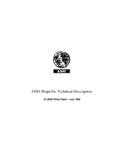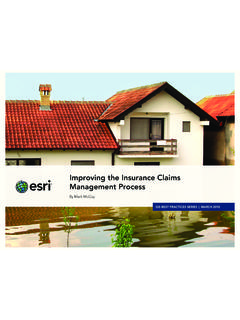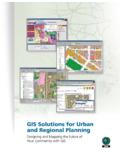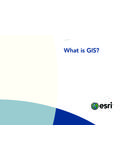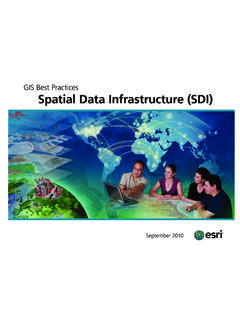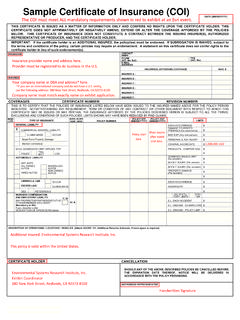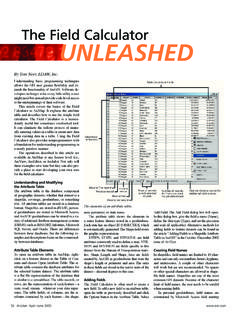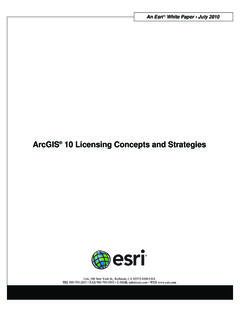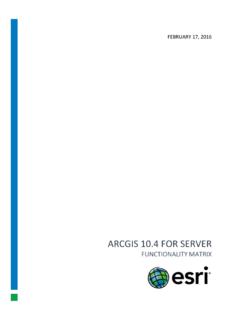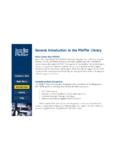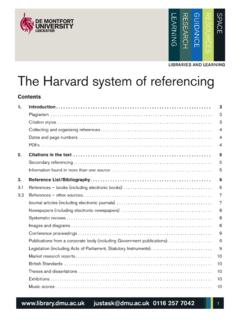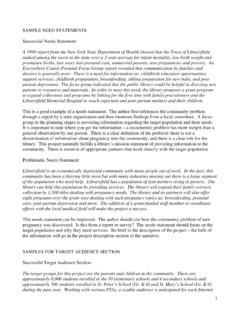Transcription of GIS Solutions for Environmental Management
1 GIS Solutions forEnvironmental ManagementMapping Your Environmental Management Solutions for Environmental ManagementResponsible and successful Environmental Management is neces-sary for protecting and restoring the natural environment. The interdependency of the earth s ecosystems and the human impact on the environment present complex challenges to governments and businesses as well as scientists and environmentalists in every discipline. Geographic information system (GIS) technology is used to support and deliver information to Environmental managers and the public. GIS allows the combination and analysis of multiple layers of location-based data including Environmental measurements.
2 The Environmental applica-tion areas of GIS are varied in terms of potential users, Environmental spheres, and the specifi c Environmental issue being s GIS Environmental Management Solutions enable organizations to Ensure accurate reporting with improved data collection. Improve decision making. Increase productivity with streamlined work processes. Provide better data analysis and presentation options. Model dynamic Environmental phenomena. Create predictive scenarios for Environmental impact studies. Automate regulatory compliance processes. Disseminate maps and share map data across the Is GIS?GIS is a powerful software technology that allows a virtually unlimited amount of information to be linked to a geo-graphic location.
3 Coupled with a digital map, GIS allows a user to see locations, events, features, and Environmental changes with unprecedented clarity, showing layer upon layer of information such as Environmental trends, soil stability, pesticide use, migration corridors, hazardous waste generators, dust source points, lake remediation efforts, and at-risk water wells. Effective Environmental practice considers the whole spectrum of the environment. ArcGIS technology offers a wide variety of analytical tools to meet the needs of many people, helping them make better deci-sions about the environment. Land and air quality Vegetation and land-use type Population density Jurisdiction boundaries Urban development Land features Hydrographic GIS for Environmental ManagementPeople in the Environmental Management community use GIS to organize existing information and communicate that information throughout their organizations.
4 GIS can be used as a strategic tool to automate processes, transform Environmental manage-ment operations by garnering new knowledge, and support deci-sions that make a profound difference on our is considered enterprise if, by design, it is part of the overall information technology architecture of the organization. ArcGIS can be integrated with most standard corporate systems such as work Management , customer service, and reporting systems. Both GIS functionality and data accessing ability can be embed-ded directly into other agency applications. GIS workflow appli-cations simplify and automate procedures within Environmental Management operations, resulting in improved efficiency and significant time savings.
5 ESRI software developers and business partners work together to bring the Environmental Management community benefit and value from GIS. This value comes from Database-sharing architecture that supports decision making and daily work tasks Interoperable system Solutions for integrated workflow and data access Internet mapping Solutions that support interagency collabora-tion projects Quality control processes that ensure accurate, high-quality data Worker-friendly designs that increase agency-wide access and application Scalability that supports and adapts to growing and evolving IT demandEnvironmental Management GIS draws from many disciplines to create meaningful.
6 Intelligent maps used by a wide variety of people for a multitude of ProductionPlanNotificationComplianceImpa ctReport ProductsInternetPrivate SectorPublic SectorInterestedOrganizationsEnvironment alGeodatabaseRecords, Documents, and TablesEnvironmental InventoriesRemote Sensing DataLandownership RecordsScanned MapsSurveyExisting Digital DataImageryBiologyCultureDemographicEnvi ronment QualitiesHydrographicHypsographic (Terrain)JurisdictionMeteorlogicLegislat ionTopographicData Sources Public policy is being shaped by the availability of high-quality geospatial data. This increasing emphasis highlights the need for coordination, collaboration, and an enterprise view of GIS Management .
7 Gregg Kreizman, Research Director, GartnerAn Environmental Management system requires the diversity of tools offered in ArcGIS to build virtual environments. GIS functionality is employed in spatial analysis, regulatory compliance, planning and Management , map publication, and New York Power Authority (NYPA) GIS-based inte-grated vegetation Management (IVM) program maintains approximately 16,000 acres of right-of-way (ROW) land. The program s principal aim is to provide the safe and reliable transmission of electric power in an economic and environmentally sensitive manner. The enterprise-wide GIS ROW application, designed for NYPA by the URS Corporation, is linked to land Management , environmen-tal, equipment maintenance, and engineering data to assist manag-ers in evaluating current vegetation conditions and prioritizing necessary maintenance.
8 By accessing multiple geographic datasets, vegetation maintenance techniques can be selected after consider-ing various factors including delineated wetlands, landowner rights and agreements, site access, Environmental regulatory compliance, security, and dangerous tree-trimming sites. The application also has a function that supports the treatment plan review process to assess Management impact on the vegetation growing in the program incorporates a mixture of cultural, physical, biologi-cal, and chemical Management practices to control targeted, higher-growing tree species. It also works to enhance the presence of more desirable lower-growth vegetation. A regular inventory and documentation of maintenance activities allow for analysis, evaluation, and continuous improvement in the overall ROW Management program.
9 The implementation of the ROW application now means that the process of vegetation Management , from scheduling treatments to evaluating Management effectiveness, is a smoother process. Field inventories are annually conducted for the rights-of-way scheduled for treatment the following year. NYPA s forestry staff members review these inventories and their suggested treatment recommendations, accepting or modifying them as they deem necessary. Once the actual fi eldwork begins, the treatment plan and related data are downloaded to fi eld computers for use by NYPA inspec-tors. These inspectors track the actual treatment in the fi eld and then upload the data to the central server for future use.
10 When a ROW fi eld visit is repeated, NYPA uses the as-treated data to analyze how well the previous treatment cycle Wingfi eld, GIS/survey manager, reports, On the fi rst line where we had a repeated cycle, we saw a 60 percent noncom-patible vegetation reduction. Presumably, on the next cycle we will see another signifi cant reduction. Eventually, because of our IVM program, we will be using only a fraction of the herbicides and manual effort we had used in the fi rst cycle. We have already saved a signifi cant amount of money in the fi rst cycle; ultimately, we will have saved money and had an ecologically positive result. To learn more about the New York Power Authority s GIS ROW application, contact Lana Khitrik of the URS Corporation at or Dave Frazier of the URS Corpora-tion at GIS in the Private SectorVegetation Management Solution Case Study New York Power AuthorityGIS integrates and provides an analytical environment for various types of information important to vegetation Management planning.
